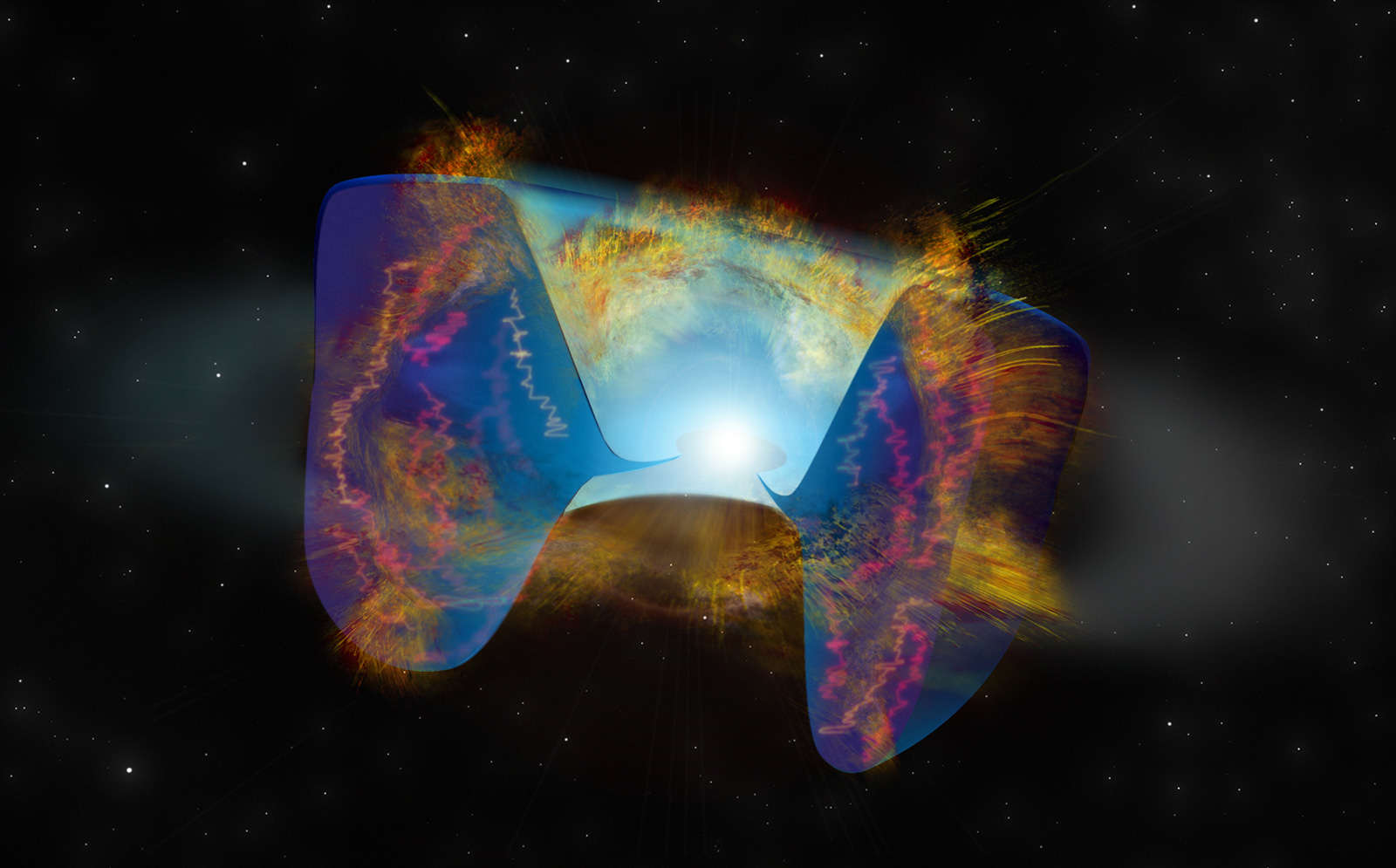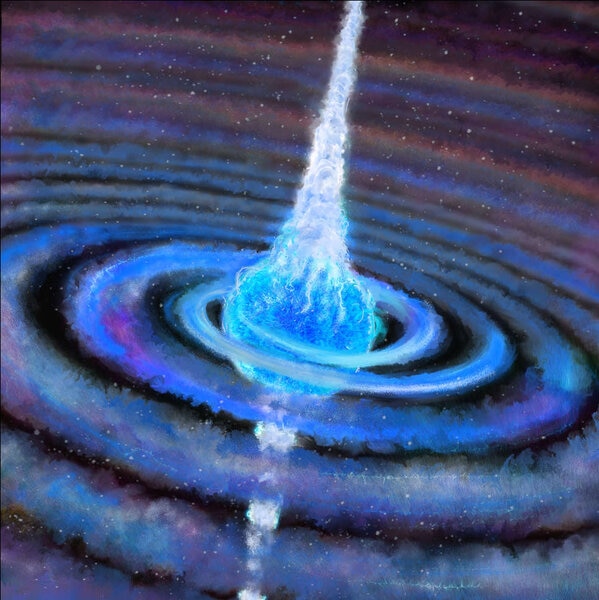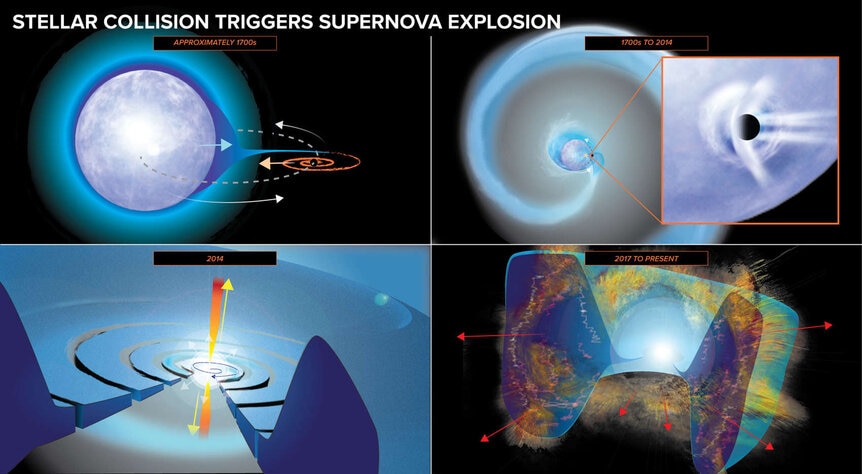Create a free profile to get unlimited access to exclusive videos, sweepstakes, and more!
So, a star may have eaten a black hole and exploded

What happens when a massive star eats a black hole or neutron star?
Theoretical models show it explodes, epically, but only after a series of events that cause the star to eruptively eject its outer layers before the compact object plunges into the star's core, disrupts it, and creates one of the most energetic events in the Universe: a supernova.
Or so the models show. But now, for the first time, astronomers may have seen an example of exactly such an event, and I am not one bit ashamed to say that several times while reading the paper about this the hairs on the back of my neck stood up. This was a fantastically violent phenomenon on a truly massive scale.
How does this work? First, many massive stars — ones more than 20 or so times the mass of the Sun, which are capable of exploding as supernovae — are born in pairs, creating a binary system of two stars in relatively close orbit. One of those stars is more massive, so it burns through its nuclear fuel first. It swells into a supergiant star, and after some complicated steps the core collapses and creates a supernova, blasting away its outer layers in a fierce explosion. The collapsed core forms what we call a compact object, a neutron star or black hole. Either way it's small (just kilometers across) and massive, with 2 or more times the Sun's mass packed into such a small volume.
Now we have a normal massive star orbited by this compact object*. Eventually the star runs out of fuel as well. But when it swells into a supergiant like its predecessor, there's a compact object there. It may actually expand past that compact object, which finds itself inside the star. The compact object will start gobbling up the material in the star's outer layers, pulling it in. It's likely orbiting faster than the star spins, so the compact object is stirring up the material in the star, whipping it around. This can cause the star to start blasting away its envelope of gas into space, flinging out a huge spiral of gas that surrounds the star.
Eventually the compact object reaches the star's core. At that point a lot of things happen rapidly. Material from the core falls onto the compact object, creating an incredibly hot disk of material and also focusing beams of matter and energy that blast away perpendicular to the disk, called jets. These jets slam into the material surrounding the star, creating a short, sharp, but very powerful blast of high-energy light like X-rays.
At the same time the intense gravity from the compact object disrupts the core, causing it to explode. Ka — and I cannot stress this enough — BOOM. Supernova.
That material screams away from the explosion at over 1,000 kilometers per second, and after some time (usually a few years) slams into the previously ejected gas from the star. This creates a shock wave that in turn creates a blast of radio waves.
As for the star's core, it collapses as well, creating another compact object. What's left when all is said and done is a compact binary system of two dead stars (a mix and match of neutron stars and/or black holes) surrounded by a lot of gas expanding rapidly outward and shining very, very brightly.
That's what the models say. Given all that is it possible to find something like this?
Assuming the models were correct, a team of astronomers decided to hunt for one of these events. They'd be rare, so they looked for historical data in archives. One of the easiest things to find would be the blast of radio waves that happens near the end, when the massive star's supernova slams into the previously ejected material.
So they searched the Very Large Array Sky Survey for any bright radio blast that could be coming from a relatively nearby galaxy that couldn't be explained by some other phenomenon, and found one: A bright flash of radio waves in a galaxy called SDSS J121001.38+495641.7 (named after the observatory that found it and its coordinates on the sky), a dwarf galaxy a bit under 500 million light years from Earth.
They observed it with the Keck observatory and found the signal of warm hydrogen gas at that same spot, which is what you'd expect to see from the material blown off the second star before it exploded. This material is glowing, well over 100,000 times brighter than the Sun!
But that's peanuts compared to what they found next. Going through archives of high-energy observatories, they found that a detector on the International Space Station called MAXI detected a burst of X-rays on August 14, 2014 consistent with the position of the VLASS radio event in the sky. The X-ray emission lasted about 15 seconds, and poured out a soul-searing 10 trillion times the Sun's energy during that time.
YEGADS. Looking at all this data, the only thing that fits is the jet from a compact-object-triggered supernova of a massive star, just like the models predicted.
In this case the compact object probably started merging with the massive star a few centuries ago (in the time frame of the star; we see these events 500 million years later once the light reaches us), which is when the star began to fling away its outer layers of gas. It took a few hundred years for the compact object to spiral in, but then it got to the star's core, tore it apart, created the jets which made the X-rays, detonated the core, and sent a few octillion tons of matter screaming outward that slammed into the gas around it, lighting it up.
To be clear, it's possible this event had some other cause — we like to be careful in science — but the compact object spiraling in and triggering a supernova fits all the data seen, and fits well enough that it's the way to bet.
So, yikes. The Universe is capable of exceedingly energetic events, ones that absolutely dwarf what we see around us on Earth, even utterly outshining the Sun and even an entire galaxy, if for a few seconds. As an astronomer I'd love for one of these to happen somewhat closer so we can get a better look, but honestly, as a human being, 500 million light years seems plenty close enough.
*Misconception alert: A lot of folks think that black holes are really massive, but they don't have to be. They can be around 3 solar masses at a minimum, though 5–10 is more likely. The normal star is much more massive than this, 20 or more times the Sun's mass. They would both orbit around their center of mass, but it's OK to think of it as the compact object orbiting the star.





























